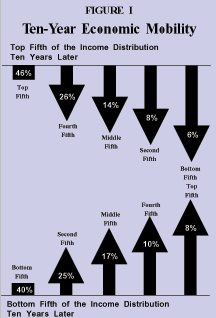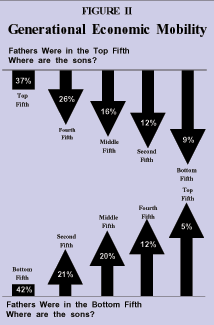The rising demand for more educated, experienced and technologically able workers has produced a more dispersed distribution of income. The increasing income gap between the highest and lowest paid workers is a concern if some groups of workers are fated to remain at the bottom of the economic ladder throughout their working lives.
The good news is that even over relatively short periods of time there is a great deal of economic mobility. As young workers gain on-the-job experience their income rises. Over longer time periods, incomes of many low-wage workers rise dramatically, while the incomes of some high-wage workers fall just as dramatically. Throughout their working lives, most workers will move up and down the wage distribution. The movements occur relative to workers of other ages and even among workers of similar ages. This income churn continues from generation to generation.
Year-to-Year Mobility. One way of looking at mobility is to divide workers into five equal groups (quintiles) by income, from highest to lowest, and identify movement between the groups over time. Changes in workers' income can be tracked using data from the Current Population Survey. A comparison of the status of workers from year to year finds:
- After one year, about one-third of the workers in the bottom income group moved to a higher group, and about one-quarter who were in the top group moved to a lower one.
- Of those who were in one of the intermediate three groups at the beginning of one year, about half move to another group by the end of the next year.
Mobility over a 10-Year Period. The probability of moving to another income group increase over longer time periods. [See Figure 1.]  Comparing the wages of workers of the same age, we find:
Comparing the wages of workers of the same age, we find:
- After 10 years, 60 percent of workers who began in the bottom group move to a higher-earning quintile.
- More than half (54 percent) of the workers in the top group move to a lower group.
- Some 8 percent of workers who began in the bottom group move all the way to the top, and 6 percent of those who began in the top group move all the way to the bottom.
Wealth Inequality. Studies of wealth accumulation also find increased inequality, but this appears to be due to differences in the degree to which people save what they earn and differences in the receipt of capital gains. Inherited wealth is not the main cause of the inequality in wealth. For instance:
- Anecdotal evidence shows almost two-thirds of the richest Americans on the Forbes 400 list in 1994 were not on the list 10 years earlier.
- And 80 percent of those on the list were self-made, as opposed to individuals who inherited fortunes.
Life-Cycle Wage Patterns. The primary reason for rising inequality of wage income is the higher wage premium paid to those with skills. This can be good news for those concerned about equality of opportunity. One of the most important factors allowing people to escape the lowest income quintile is the acquisition of education and job skills. Moreover, on-the-job training tends to naturally make workers more valuable over the course of a work life. For example:
- White male workers tend to be at the 20th percentile in the overall white men's wage distribution at age 21, meaning that only 20 percent of workers earn less than they do and 80 percent earn more.
- However, after 10 years of job experience (when the 21 year olds become 31), they reach the 50th percentile – earning the average wage for all white male workers.
- Between 31 and 59 years of age they average near the 60th percentile – earning more than 60 percent of all workers at that point.
- However, as these workers near retirement, they fall back to the average wage again.
Mobility Across Generations. Children do not remain in the same income group as their parents or grandparents:
- Only 31 percent of children are in the same income quintile as their parents.
- To put this in perspective, 20 percent would be in the same group just by random chance.
Furthermore, income differences between high and low income earners tend to be eliminated by the third generation, on the average. Comparing data on men's earnings a generation ago with the earnings of their sons, we find:
- Almost two-thirds of the sons of the fathers in the highest income group were in lower income group. [See Figure II.]
- Nearly 60 percent of the sons of the fathers in the bottom income quintile moved to a higher group.

Ways to Increase Mobility. Education can overcome differences in parental income, increases the likelihood of escaping low income and maintaining high income, and is a determinant of one's progress through the earnings distribution during one's life. Public policies can help create opportunities and encourage economic mobility. Such policies include:
- Improving educational opportunities, especially for low-income children – by encouraging competition and choice among schools.
- Continuing to reform the welfare system, so that young men and women are not encouraged to choose leisure over work.
- Deregulating the labor market, making it easier for young people to enter new occupations and acquire job skills.
- Making it easier for people to save what they earn, so they can accumulate assets over their work lives.
Conclusion. Climbing the economic ladder is more the norm than the exception. Knowledge and skill, as measured by education and experience, facilitates economic mobility. Individuals who have responded to the incentives implicit in the increased earnings inequality have experienced the greatest mobility. The implication is that public policies providing individuals and their families greater freedom and opportunity to invest in themselves and their children will have the greatest positive impact on economic success.
This Brief Analysis is based on "Climbing the Economic Ladder," by Andrew J. Rettenmaier and Donald R. Deere, prepared for the Financial Services Roundtable by the NCPA. Rettenmaier is Executive Associate Director at the Private Enterprise Research Center at Texas A&M University and a senior fellow with the National Center for Policy Analysis.